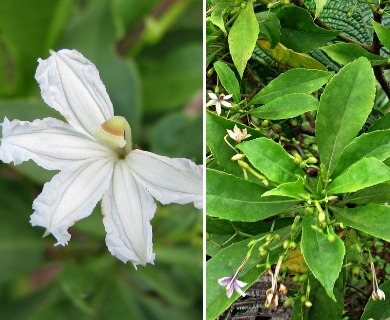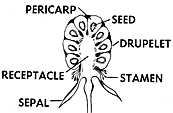Mountain Naupaka
Scaevola gaudichaudiana
Beachberry family (Goodeniaceae)
Native species ()
The Scaevola with about nine species in Hawaii, mostly shrubs, is easily recognized by the as in a half flower. This example, mountain naupaka, is a much branched native shrub of wet mountain areas, has the distinctive fragrant white flowers with narrow tubular split to base and five narrow spreading on one side. Sometimes a small tree up to 16 ft (5 ) tall and 3 inches (7.5 ) in diameter. Bark light brown. Twigs are slender, greenish, hairless except for tufts at the base of young leaves.

©2008 David Eickhoff
Flower clusters () at leaf bases, becoming slightly longer than leaves, with slender forking branches often zigzagging, bearing 10–17 flowers, the end flower opening first. Flowers almost 3⁄4 inch (2 ) long, composed of greenish base () about 1⁄16 inch (1.5 ) long with tiny rim of five- (bilaterally symmetrical), narrow tubular white but turning yellowish, about 5⁄8 inch (1.5 ) long, split to base and five narrow three-pointed about 3⁄8 inch (1 ) as in a hall flower; five slender almost as long as tube, withering early; and with inferior two-celled slender curved greenish and enlarged Flowering nearly through the year.
() elliptical, about 1⁄4 inch (6 ) long with rim at hairless, shiny purplish black (whitish in a form), with purple juice, containing large elliptical pointed two-celled stone. Seeds one or two. Common in the understory of open wet forests and in open areas at 600–2600 ft (183–792 ) elevation.
Special area
Waimea Arboretum
Range
Kauai and Oahu only
Other common names
naupaka, Gaudichaud scaevola, half-flower
This species honors Charles Gaudichaud-Beaupre (1789–1854), French botanist on the world scientific cruise of the Uranie. He collected in Hawaii in 1819 and published the first report on the Hawaiian flora. It has been known also by the name of a closely related species, Scaevola chamissonana Gaud. That species is a slightly smaller shrub of Molokai, Lanai, Maui, and Hawaii. It has leaves with fewer branching side veins, tufts of hairs in vein angles, and several prominent sharp teeth; large flowers 1–1 1⁄4 inches (2.5–3 ) long, with longer pointed white often with violet lines; and larger more than 1⁄2 inch (13 ) long.
Botanical
Scaevola taccada (Gaertn.) Roxb., S. frutescens Krause
Naupaka kahakai or beach naupaka, Scaevola sericea Vahl, is a common native much branched shrub on beaches through the Hawaiian Islands and other Pacific Islands to the western Indian Ocean. It has fleshy hairy stout twigs, elliptical blunt-pointed, thick brittle, light green leaves finely hairy beneath, yellowish white flowers, and white Other common names: naupaka kai, huakekili, aupaka.
The odd half-flower of this has been the source of several Hawaiian legends. The following is from Degener (1933–1986): “ ... two lovers were forced to be separated by the man’s departure for war on another island. On taking leave, he tore a naupaka blossom in half, saying: ‘When the flower is whole again I shall return.’ To this day the naupaka flower is seemingly only half a flower as a sad reminder that the man never returned from battle.”
Neal (1965, p. 820–821) had two other versions, quoted in full:
“According to an old Hawaiian chant, the ocean naupaka was born of heaven and earth. The story of the naupaka flower, thought of recent origin, is one of the best known of Hawaii. It has several variants. Two lovers quarreled and the maiden tore a naupaka flower in two and declared she would not love her old sweetheart again until he should bring to her a flower. He searched in vain all over the islands, for these flowers, whether they grew on the seashore, on the plains, or in the mountains, had become but half flowers. And it is said that he died of a broken heart.
“Another story tells of a beautiful stranger who fell in love with a village youth. When he turned from her and went back to his sweetheart, the beautiful woman followed him and tore him from her embrace. Anger blazed about the woman, and they knew that she was Pele, goddess of volcanoes. She pursued the youth into the mountains hurling lava after him. Then the gods took pity on him and transformed him into a half flower, the naupaka. Pele shrieked with rage and fled on a river of lava to the ocean. She overtook the maid, whom the gods turned into a beach naupaka. The lovers are forever separated, for the half flowers of the youth still bloom alone in the mountains, and the half flowers of the maiden blossom alone on the beach.”








